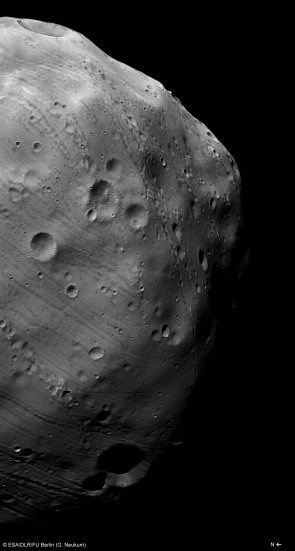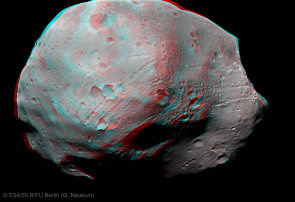Mars Express heading towards daring flyby of Phobos
23 December 2013
Late this month, ESA's Mars Express will make the closest flyby yet of the Red Planet’s largest moon Phobos, skimming past at only 45 km above its surface.| Phobos 360 (Click here for further details and larger versions of this video). Credit: ESA/DLR/FU Berlin (G. Neukum), CC BY-SA IGO 3.0 |
The flyby on 29 December will be so close and fast that Mars Express will not be able to take any images, but instead it will yield the most accurate details yet of the moon's gravitational field and, in turn, provide new details of its internal structure.
As the spacecraft passes close to Phobos, it will be pulled slightly off course by the moon's gravity, changing the spacecraft's velocity by no more than a few centimetres per second. These small deviations will be reflected in the spacecraft's radio signals as they are beamed back to Earth, and scientists can then translate them into measurements of the mass and density structure inside the moon.
 |
| Mars Express HRSC image of Phobos, taken on 7 March 2010. Credit: ESA/DLR/FU Berlin (G. Neukum), CC BY-SA IGO 3.0 |
Earlier flybys, including the previous closest approach of 67 km in March 2010, have already suggested that the moon could be between a quarter and a third empty space – essentially a rubble pile with large spaces between the rocky blocks that make up the moon's interior.
Knowing the structure of the roughly 27 × 22 × 18 km Phobos will help to solve a big mystery concerning its origin and that of its more distant sibling, Deimos, which orbits Mars at approximately three times greater distance.
The leading theories propose that the duo are either asteroids captured by Mars, or that they were born from debris thrown up from giant impacts on Mars.
"By making close flybys of Phobos with Mars Express in this way, we can help to put constraints on the origin of these mysterious moons," says Olivier Witasse, ESA's Mars Express project scientist.
In addition to probing the gravitational field of Phobos during its close approach, Mars Express will be making measurements of how the solar wind influences the moon's surface.
"At just 45 km from the surface, our spacecraft is passing almost within touching distance of Phobos," says Michel Denis, Mars Express Operations Manager.
"We've been carrying out manoeuvres every few months to put the spacecraft on track and, together with the ground stations that will be monitoring it on its close approach, we are ready to make some extremely accurate measurements at Phobos."
Both the position of the spacecraft and the moon must be known to high precision in order to make the most accurate calculations of the moon's internal characteristics. To improve the positional data, the spacecraft's high-resolution stereo camera has been capturing images of Phobos set against the background star field in the weeks leading up to closest approach and will continue to do so afterwards.
 |
| Phobos in 3D. Credit: ESA/DLR/FU Berlin (G. Neukum), CC BY-SA IGO 3.0 |
Furthermore, ground stations around the world will track the spacecraft for a total of 35 hours in the lead up to, during, and after the flyby to ensure that the position of Mars Express is precisely known.
"Mars Express entered orbit around the Red Planet exactly ten years ago this week – this close flyby of Phobos is certainly an exciting way to celebrate!" adds Olivier.
For updates on the success of the flyby on 29 December, follow the Mars Express blog. Scientific results from the flyby may take several weeks to analyse.
(This article was originally published on ESA's Space Science Portal)


